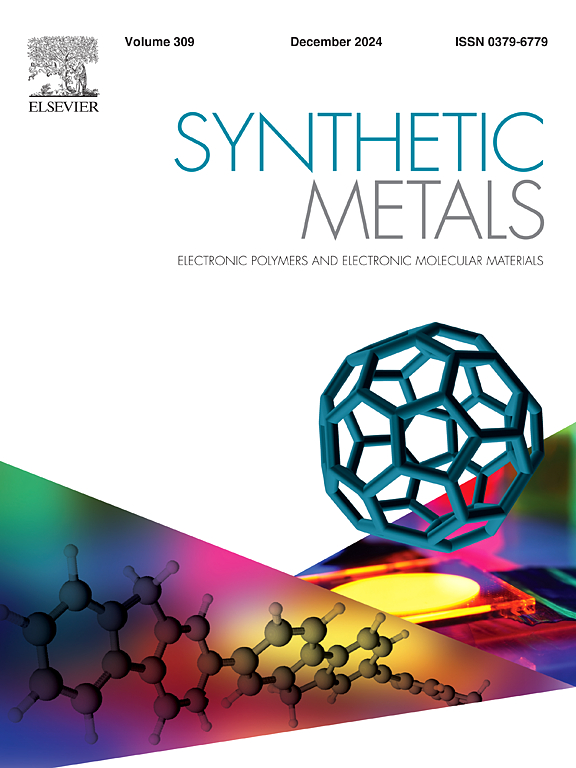用于多巴胺电化学检测的NiO-rGO/Mo2Ti2C3三元复合材料的简易设计
IF 4.6
3区 材料科学
Q2 MATERIALS SCIENCE, MULTIDISCIPLINARY
引用次数: 0
摘要
在本研究中,通过原位法合成了NiO-rGO/Mo2Ti2C3 MXene三元杂化材料,该材料将工业石墨废料中的电化学活性rGO、MAX相中的Mo2Ti2C3 (Mo2Ti2AlC3)和NiO纳米颗粒结合在一起。通过XRD、FTIR、UV-Vis、拉曼光谱、SEM-EDS、HR-TEM、BET和XPS等分析,确定了NiO-rGO/Mo2Ti2C3的结构完整性和元素组成。rGO和MXene与NiO纳米颗粒的协同作用促进了NiO-rGO/Mo2Ti2C3作为潜在的电催化剂增强多巴胺的电催化氧化。ngm21修饰电极在多巴胺检测中表现出优异的电化学性能,灵敏度高(1.441 × 10−4 μA μM−1),检测范围宽(0.002 ~ 0.012 μM),定量限为4.79 nM,检出限低为1.44 nM。循环伏安法和差分脉冲伏安法分析表明,ngm21修饰电极在电催化检测多巴胺时电流响应快、选择性好、受常用分析物干扰小。此外,真实样品分析具有良好的再现性,尿液样品的回收率为107 %,血清样品的回收率为98-103 %。因此,研究结果表明,三元NiO-rGO/Mo2Ti2C3是一种稳健可靠的电极材料,可用于医学应用中的神经递质多巴胺的电化学检测。本文章由计算机程序翻译,如有差异,请以英文原文为准。
Facile design of NiO-rGO/Mo2Ti2C3 ternary composites for electrochemical detection of dopamine
In this study, a ternary NiO-rGO/Mo2Ti2C3 MXene hybrid materials were synthesized through an in-situ approach, integrating electrochemically active rGO derived from industrial graphite waste, Mo2Ti2C3 derived from MAX phase (Mo2Ti2AlC3) and NiO nanoparticles. XRD, FTIR, UV-Vis, Raman spectroscopy, SEM-EDS, HR-TEM, BET, and XPS analysis were done to confirm the structural integrity and elemental composition of NiO-rGO/Mo2Ti2C3. The synergistic effects of rGO and MXene with NiO nanoparticles facilitate NiO-rGO/Mo2Ti2C3 as a potential electrocatalyst to enhance the electrocatalytic oxidation of dopamine. The NGM21-modified electrode exhibited superior electrochemical performance for dopamine detection, demonstrating high sensitivity (1.441 × 10−4 μA μM−1), a broad detection range (0.002–0.012 μM), a limit of quantification of 4.79 nM, and a low detection limit of 1.44 nM. Cyclic voltammetry and differential pulse voltammetry analysis of NGM21-modified electrode revealed rapid current response, excellent selectivity, and minimal interference from common analytes in the electrocatalytic detection of dopamine. Furthermore, real sample analysis demonstrated remarkable reproducibility, with recovery rates of 107 % in urine and 98–103 % in serum samples. Therefore, the results suggest that the ternary NiO-rGO/Mo2Ti2C3 is a robust and reliable electrode material for the electrochemical detection of the neurotransmitter dopamine in medical applications.
求助全文
通过发布文献求助,成功后即可免费获取论文全文。
去求助
来源期刊

Synthetic Metals
工程技术-材料科学:综合
CiteScore
8.30
自引率
4.50%
发文量
189
审稿时长
33 days
期刊介绍:
This journal is an international medium for the rapid publication of original research papers, short communications and subject reviews dealing with research on and applications of electronic polymers and electronic molecular materials including novel carbon architectures. These functional materials have the properties of metals, semiconductors or magnets and are distinguishable from elemental and alloy/binary metals, semiconductors and magnets.
 求助内容:
求助内容: 应助结果提醒方式:
应助结果提醒方式:


